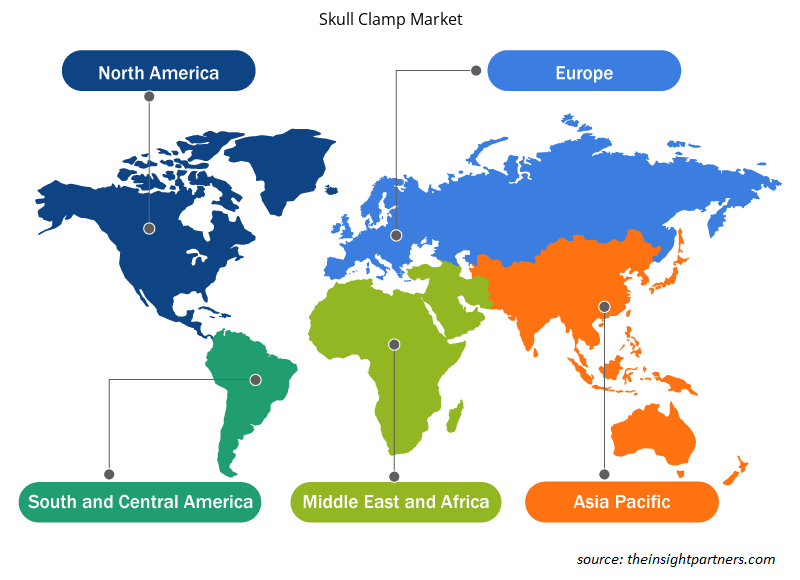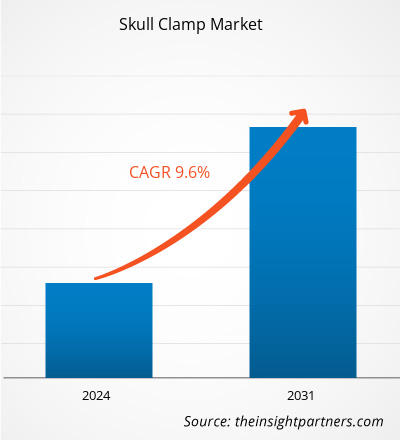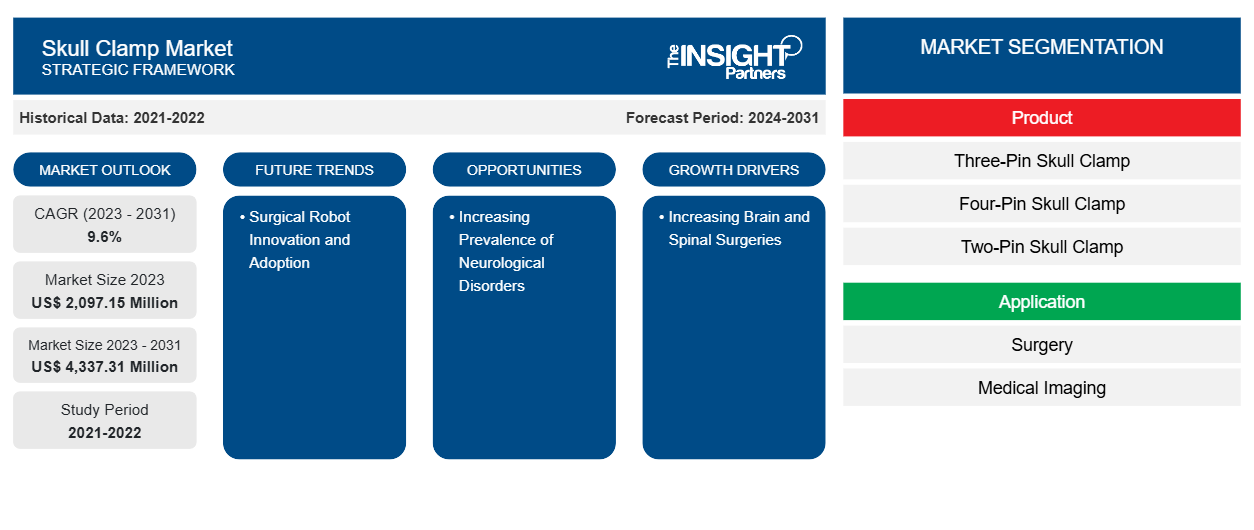La taille du marché des pinces crâniennes devrait atteindre 4 337,31 millions USD d'ici 2031, contre 2 097,15 millions USD en 2023. Le marché devrait enregistrer un TCAC de 9,6 % au cours de la période 2023-2031. L'acceptation des techniques robotiques pour le traitement des maladies cérébrales devrait augmenter en raison de leur capacité à améliorer les performances avec une grande précision, une plus grande flexibilité et une récupération accélérée ; ainsi, l'augmentation de l'innovation et de l'adoption chirurgicales devrait rester une tendance clé du marché au cours de la période de prévision.CAGR of 9.6% during 2023–2031. The acceptance of robotic techniques for treating brain diseases is expected to increase due to their ability to improve performance with high accuracy, greater flexibility, and accelerated recovery; thus, increasing surgical innovation and adoption is likely to remain a key trend in the market during the forecast period.
Analyse du marché des pinces crâniennes
L'augmentation de l'incidence des traumatismes crâniens et l'augmentation des interventions sur le cerveau et la colonne vertébrale sont parmi les principaux moteurs de la croissance du marché des pinces crâniennes . Cependant, l'incidence croissante des blessures provoquées par les pinces crâniennes.
Aperçu du marché des pinces crâniennes
Les pinces crâniennes sont fréquemment utilisées dans les interventions neurochirurgicales crâniennes et certaines interventions cervicales. Leur demande est principalement due au nombre croissant d'interventions neurochirurgicales en raison de l'incidence croissante des tumeurs cérébrales et de la colonne vertébrale, des anévrismes cérébraux et de la maladie de Parkinson.neurosurgeries owing to the rising incidence of brain and spinal tumors, brain aneurysms or cerebral aneurysms, and Parkinson’s disease.
Selon les données publiées par la Brain Aneurysm Foundation, environ 6,5 millions de personnes aux États-Unis (soit 1 personne sur 50) souffrent chaque année d'un anévrisme cérébral non rompu, et environ 30 000 personnes souffrent d'une rupture d'anévrisme cérébral chaque année. Les données révèlent également qu'environ 40,0 % des ruptures sont mortelles et nécessitent des soins intensifs et une attention immédiate. Selon les informations de la National Library of Medicine en 2022, la prévalence mondiale des anévrismes cérébraux était d'environ 3,2 %, avec un âge moyen de 50 ans et un ratio global de 1:1 entre les sexes ; ce ratio change considérablement chez les personnes de 50 ans et plus pour atteindre 2:0, avec une prédominance de femmes. En outre, selon l'American Cancer Society, en 2023, environ 25 400 adultes aux États-Unis ont été diagnostiqués avec des tumeurs malignes de la moelle épinière et du cerveau, et environ 18 760 personnes en mourront. Le positionnement du patient et la fixation de la tête sont les aspects les plus cruciaux de toutes les opérations chirurgicales du cerveau. Ces procédures nécessitent une compréhension précise de l'anatomie du cuir chevelu et du crâne et de la procédure d'obtention des anévrismes. Par conséquent, la prévalence croissante des anévrismes cérébraux, du cancer du cerveau et d'autres maladies neurologiques qui nécessitent des interventions chirurgicales fait partie des facteurs cruciaux qui stimulent la croissance du marché des pinces crâniennes.
Personnalisez ce rapport en fonction de vos besoins
Vous bénéficierez d'une personnalisation gratuite de n'importe quel rapport, y compris de certaines parties de ce rapport, d'une analyse au niveau des pays, d'un pack de données Excel, ainsi que de superbes offres et réductions pour les start-ups et les universités.
-
Obtenez les principales tendances clés du marché de ce rapport.Cet échantillon GRATUIT comprendra une analyse de données, allant des tendances du marché aux estimations et prévisions.
Moteurs et opportunités du marché des serre-têtes
Le nombre croissant de cas de lésions cérébrales traumatiques favorise le marché
Les traumatismes crâniens (TC) surviennent souvent à la suite de blessures sportives graves ou d'accidents de la route. Il existe quatre principaux types de TCC : commotion cérébrale, contusion, lésions pénétrantes et lésions cérébrales anoxiques. Les symptômes des TCC diffèrent selon l'étendue des dommages au cerveau. Selon les Centers for Disease Control and Prevention (CDC), il y a eu environ 69 000 décès liés à des TCC aux États-Unis en 2021. Un rapport de la Brain Injury Association of America (BIAA) indique qu'environ 2,8 millions de personnes aux États-Unis souffrent de TCC chaque année, et environ 280 000 de ces cas entraînent une hospitalisation, dont environ 50 000 blessures mortelles. Selon un article intitulé « Traumatic Brain Injury: A 'silent epidemic' », environ 2 millions d'Américains souffrent de TCC chaque année, et environ 100 000 personnes en meurent. De même, selon la Brain Injury Association Waterloo-Wellington, environ 11 000 décès sont observés chaque année en raison de lésions cérébrales traumatiques au Canada, ce qui entraîne plus de 6 000 personnes handicapées de façon permanente en raison de lésions cérébrales post-traumatiques. De plus, selon la Commission européenne, environ 2,5 millions de personnes souffrent d'un traumatisme crânien chaque année dans l'Union européenne et au Royaume-Uni, dont 1,5 million sont hospitalisées et 57 000 décèdent.
La craniectomie décompressive (CD) est un traitement chirurgical extrême de l'hypertension intracrânienne (ICP) médicalement réfractaire après un traumatisme crânien ; elle est souvent réalisée en chirurgie urgente (CD primaire). À l'aide d'une pince crânienne, les professionnels de la santé peuvent traiter chirurgicalement un traumatisme crânien en utilisant la DC. Avec l'augmentation des cas de traumatisme crânien, le nombre d'opérations chirurgicales du cerveau pratiquées augmente dans divers pays, ce qui renforce l'utilisation de pinces crâniennes pour empêcher le mouvement involontaire de la tête lors des opérations.
L’augmentation de la prévalence des troubles neurologiques crée des opportunités de marché
Français On observe une prévalence croissante de troubles neurologiques tels que la maladie d'Alzheimer, la maladie de Parkinson et l'épilepsie, principalement dans les pays à revenu faible et intermédiaire. Selon l'OMS, en 2024, environ 50 millions de personnes dans le monde souffriront d'épilepsie, et environ 80 % de ces personnes vivent dans des pays à revenu faible ou intermédiaire. Selon la Parkinson's Foundation, près d'un million de personnes aux États-Unis étaient atteintes de la maladie de Parkinson en 2023, et les cas de la maladie devraient atteindre 1,2 million d'ici 2030. Selon la même source, en 2023, plus de 10 millions de personnes dans le monde souffraient de la maladie de Parkinson. Selon l'Alzheimer's Association, environ 6,9 millions de personnes âgées de 65 ans et plus en Amérique devraient souffrir de la maladie d'Alzheimer en 2024. Des médicaments sont généralement utilisés pour le traitement de ces maladies. Cependant, on assiste à une augmentation de l’intérêt porté à l’utilisation de méthodes chirurgicales telles que la stimulation cérébrale profonde pour le traitement des troubles neurologiques, en particulier lorsque les médicaments ont de faibles effets. Selon un article intitulé « Epilepsy Surgery », les patients épileptiques peuvent être traités à l’aide d’une petite électrode. Selon le même article, environ 50 % des patients qui subissent des chirurgies de neuromodulation peuvent bénéficier d’un meilleur contrôle de leurs crises. Entre 50 % et 85 % des personnes qui subissent une chirurgie de résection ou une hémisphérectomie peuvent bénéficier d’une amélioration significative du contrôle des crises et devenir sans crise dans certains cas. En raison des meilleurs résultats des interventions chirurgicales pour les troubles neurologiques, le nombre de patients qui opteront pour ces options augmentera, ce qui, à son tour, alimentera le nombre de chirurgies neurologiques. Comme ces chirurgies sont liées au cerveau, la stabilisation du crâne pendant la chirurgie est importante. Ainsi, il y aura une augmentation de la demande de pinces crâniennes. Ainsi, la prévalence croissante des troubles neurologiques devrait offrir des opportunités lucratives pour la croissance du marché des pinces crâniennes au cours de la période de prévision.neuromodulation surgeries may experience better control of their seizures. Between 50% and 85% of individuals who undergo resection surgery or a hemispherectomy may experience significant improvement in seizure control and become seizure-free in some cases. Due to the better results of surgical procedures for neurological disorders, there will be an increase in the number of patients that will opt for these options, which, in turn, will fuel the number of neurological surgeries. As these surgeries are related to the brain, stabilization of the skull during the surgery is important. Thus, there will be an increase in demand for skull clamps. Thus, the increasing prevalence of neurological disorders is expected to offer lucrative opportunities for the growth of the skull clamp market during the forecast period.
Analyse de segmentation du rapport sur le marché des pinces crâniennes
Les segments clés qui ont contribué à l’élaboration de l’analyse du marché des pinces crâniennes sont le produit, l’application, le matériau et l’utilisateur final.
- En fonction du produit, le marché des pinces crâniennes est segmenté en pinces crâniennes à trois broches, pinces crâniennes à quatre broches et pinces crâniennes à deux broches. Le segment des pinces crâniennes à trois broches détenait la plus grande part de marché en 2023.
- En termes d'application, le marché est divisé en chirurgie et imagerie médicale. Le segment de la chirurgie représentait une part plus importante du marché en 2023.
- En termes de matériaux, le marché est segmenté en acier inoxydable, alliage d'aluminium, titane et radiotransparent. Le segment de l'acier inoxydable représentait la plus grande part du marché en 2023.
- En fonction des accessoires, le marché des pinces crâniennes est segmenté en broches crâniennes, appui-tête et autres. Le segment des broches crâniennes détenait la plus grande part de marché en 2023.
- En fonction de l'utilisateur final, le marché des pinces crâniennes est segmenté en hôpitaux, cliniques spécialisées et centres de chirurgie ambulatoire. Le segment des hôpitaux a dominé le marché en 2023.
Analyse des parts de marché des serre-têtes par géographie
Français La portée géographique du rapport sur le marché des pinces crâniennes est principalement divisée en cinq régions : Amérique du Nord, Asie-Pacifique, Europe, Moyen-Orient et Afrique, et Amérique du Sud et centrale. L'Amérique du Nord a dominé le marché en 2023. Le marché nord-américain a été analysé sur la base des États-Unis, du Canada et du Mexique. En termes de revenus, l'Amérique du Nord représentait la plus grande part de marché mondiale des pinces crâniennes en 2023. Les États-Unis détiennent une part importante du marché en Amérique du Nord. Les traumatismes crâniens (TCC) sont considérés comme l'une des principales causes de décès et d'invalidité parmi la majorité de la population aux États-Unis. Le CDC a déclaré que 69 473 décès liés aux TCC sont survenus en 2021, tandis qu'environ 214 110 hospitalisations liées aux TCC ont été enregistrées en 2020. Cela se traduit par plus de 586 admissions à l'hôpital et 190 décès liés aux TCC chaque jour. Les hospitalisations et les taux de mortalité liés aux TCC étaient plus élevés chez les personnes âgées de 75 ans et plus. Cette tranche d'âge est responsable d'environ 32 % des hospitalisations liées aux lésions cérébrales traumatiques et de 28 % des décès liés aux lésions cérébrales traumatiques. Selon les Centers for Disease Control and Prevention (CDC), le coût du traitement des lésions cérébrales traumatiques aux États-Unis s'élève à environ 45 milliards de dollars par an. De plus, on estime que 80 000 à 90 000 patients aux États-Unis souffrent chaque année d'invalidités dues à des lésions cérébrales traumatiques. En outre, la pénétration des pinces crâniennes dans plusieurs applications pour utilisateurs finaux devrait accroître le développement de produits, ce qui devrait alimenter le marché des pinces crâniennes aux États-Unis d'ici 2030.
Aperçu régional du marché des serre-têtes
Les tendances régionales et les facteurs influençant le marché des pinces crâniennes tout au long de la période de prévision ont été expliqués en détail par les analystes d’Insight Partners. Cette section traite également des segments et de la géographie du marché des pinces crâniennes en Amérique du Nord, en Europe, en Asie-Pacifique, au Moyen-Orient et en Afrique, ainsi qu’en Amérique du Sud et en Amérique centrale.

- Obtenez les données régionales spécifiques au marché des pinces crâniennes
Portée du rapport sur le marché des pinces crâniennes
| Attribut de rapport | Détails |
|---|---|
| Taille du marché en 2023 | 2 097,15 millions de dollars américains |
| Taille du marché d'ici 2031 | 4 337,31 millions de dollars américains |
| Taux de croissance annuel composé mondial (2023-2031) | 9,6% |
| Données historiques | 2021-2022 |
| Période de prévision | 2024-2031 |
| Segments couverts |
Par produit
|
| Régions et pays couverts |
Amérique du Nord
|
| Leaders du marché et profils d'entreprises clés |
|
Densité des acteurs du marché : comprendre son impact sur la dynamique des entreprises
Le marché des serre-crânes connaît une croissance rapide, tirée par la demande croissante des utilisateurs finaux en raison de facteurs tels que l'évolution des préférences des consommateurs, les avancées technologiques et une plus grande sensibilisation aux avantages du produit. À mesure que la demande augmente, les entreprises élargissent leurs offres, innovent pour répondre aux besoins des consommateurs et capitalisent sur les tendances émergentes, ce qui alimente davantage la croissance du marché.
La densité des acteurs du marché fait référence à la répartition des entreprises ou des sociétés opérant sur un marché ou un secteur particulier. Elle indique le nombre de concurrents (acteurs du marché) présents sur un marché donné par rapport à sa taille ou à sa valeur marchande totale.
Les principales entreprises opérant sur le marché des pinces crâniennes sont :
- Groupe Médical de la Forêt Noire;
- Integra LifeSciences Holdings Corp ;
- Innovations chirurgicales TeDan ;
- Barrfab Industria Commerce Import & Export d'équipements hospitaliers Ltda;
- Herbert Thaïlande Co Ltd;
- Medifa GmbH & Co KG;
Avis de non-responsabilité : les sociétés répertoriées ci-dessus ne sont pas classées dans un ordre particulier.

- Obtenez un aperçu des principaux acteurs du marché de Skull Clamp
Actualités et développements récents du marché des serre-crânes
Le marché des pinces crâniennes est évalué en collectant des données qualitatives et quantitatives après des recherches primaires et secondaires, qui comprennent d'importantes publications d'entreprise, des données d'association et des bases de données. Quelques-uns des développements du marché sont énumérés ci-dessous :
- Le groupe Medifa Healthcare a annoncé un partenariat stratégique avec GmbH et medimex GmbH pour distribuer des tables d'opération, des éclairages opératoires et des systèmes de salles modulaires liés aux projets « RooSy » en Allemagne. (Source : Medifa Healthcare Group, site Web de l'entreprise, janvier 2022)
Rapport sur le marché des pinces crâniennes et livrables
Le rapport « Taille et prévisions du marché des pinces crâniennes (2021-2031) » fournit une analyse détaillée du marché couvrant les domaines ci-dessous :
- Taille du marché des pinces crâniennes et prévisions aux niveaux mondial, régional et national pour tous les segments de marché clés couverts par le périmètre
- Tendances du marché des pinces crâniennes ainsi que la dynamique du marché telles que les facteurs moteurs, les contraintes et les opportunités clés
- Analyse détaillée des cinq forces de PEST/Porter et SWOT
- Analyse du marché des pinces crâniennes couvrant les principales tendances du marché, le cadre mondial et régional, les principaux acteurs, les réglementations et les développements récents du marché
- Analyse du paysage industriel et de la concurrence couvrant la concentration du marché, l'analyse de la carte thermique, les principaux acteurs et les développements récents pour le marché des pinces crâniennes
- Profils d'entreprise détaillés
- Analyse historique (2 ans), année de base, prévision (7 ans) avec TCAC
- Analyse PEST et SWOT
- Taille du marché Valeur / Volume - Mondial, Régional, Pays
- Industrie et paysage concurrentiel
- Ensemble de données Excel
Rapports récents
Témoignages
Raison d'acheter
- Prise de décision éclairée
- Compréhension de la dynamique du marché
- Analyse concurrentielle
- Connaissances clients
- Prévisions de marché
- Atténuation des risques
- Planification stratégique
- Justification des investissements
- Identification des marchés émergents
- Amélioration des stratégies marketing
- Amélioration de l'efficacité opérationnelle
- Alignement sur les tendances réglementaires























 Obtenez un échantillon gratuit pour - Marché des pinces à crâne
Obtenez un échantillon gratuit pour - Marché des pinces à crâne